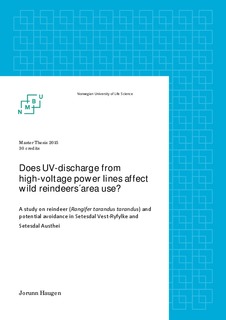| dc.contributor.author | Haugen, Jorunn | |
| dc.date.accessioned | 2015-11-05T11:27:47Z | |
| dc.date.available | 2015-11-05T11:27:47Z | |
| dc.date.copyright | 2015 | |
| dc.date.issued | 2015-11-05 | |
| dc.identifier.uri | http://hdl.handle.net/11250/2359421 | |
| dc.description.abstract | Human activities and infrastructure continue to increase in northern regions, and in Scandinavia, the progressive development of wind and hydroelectric power, cabins, roads, and power lines is in conflict with the conservation of wild reindeer (Rangifer tarandus tarandus) habitat. High voltage power lines produce corona noise and UV-discharges under particular weather conditions. A new hypothesis suggests that avoidance behavior in reindeer towards power lines might be linked with their adaptive UV-sensitive vision in winter combined with unpredictable UV outburst from high-voltage power lines. However, studies based on GPS data from several Norwegian reindeer populations have found limited negative effects of power lines alone or after the period of construction. The objective of this study was to test the “UV-hypothesis” for wild reindeer in Setesdal Vest-Ryfylke and Setesdal Austhei using data from GPS-collared reindeer for the years 2007 - 2014. Area use was studied within three test areas with 420 kV and 300 kV power lines and numerous control lines throughout the landscape. This study tested differences in area use between nighttime and daytime within a 1 km, 500 m, 200 m and 100 m corridor for autumn, winter and spring. The “UV”hypothesis was not supported by my results. For all real power lines, there was no significant differences between daytime and nighttime in relation to distance to power line within the 1 km, 500 m, 200 m and 100 m corridors. This applies to both Setesdal Vest-Ryfylke and Setesdal Austhei. These results indicate that wild reindeer in Setesdal Vest-Ryfylke and Setesdal Austhei are not negatively affected by UV-discharge, nor show any aversion towards high voltage power lines during nighttime. Power lines do not facilitate human use after development and this could lead to a more rapid habituation. Over time, reindeer might habituate to UV-discharge stimuli because there is no danger related to the electrical phenomenon. However, UV-discharge might be more dominant under particular weather conditions, thus, future studies should include weather data. Also, due to classical conditioning, (or even large time scale autocorrelation) negative effects during nighttime may also lead to negative effects during daytime. This may be the reason for why there is an increase in density of GPS-points further away from the power line in Setesdal Austhei North and Setesdal Vest-Ryfylke South. It may also be caused by other factors like elevation, snow depth or vegetation, especially since the same trend is not found in all three areas. To investigate this further, these other factors should be included in future analyses. | nb_NO |
| dc.description.abstract | Utbygging av infrastruktur har økt de siste tiår i Skandinavia og utviklingen av vind- og vannkraft, hytter, veier og kraftledninger kommer i konflikt med bevaring av villreinens (Rangifer tarandus tarandus) habitat. Høyspentledninger produserer corona-effekter som støy og UV-utladninger under spesielle værforhold. En ny hypotese antyder at unngåelse av kraftlinjer hos villrein kan ha en sammenheng med deres UV-sensitive syn om vinteren, kombinert med uforutsigbare UV-utladninger fra høyspentledninger. Studier basert på GPS-data fra flere norske bestander av reinsdyr har funnet begrensede negative effekter av kraftledninger under eller etter utbygging. Målet med studie var å teste "UV-hypotesen" i Setesdal Vest – Ryfylke og Setesdal Austhei ved å bruke data fra GPS-merkede villrein for årene 2007-2014. Tre test-områder med 420 kV og 300 kV kraftledninger ble valgt ut, i tillegg til flere kontroll-linjer i lignende landskap i nærliggende områder. Studiet testet forskjell i villreinens bruk av områdene mellom natt og dag for høst, vinter og vår innenfor en sone på 1 km, 500 m, 200 m og 100 m. "UV"–hypotesen kunne ikke støttes ut i fra mine resultater. For alle eksisterende kraftlinjer som ble testet var det ingen signifikant forskjell i villreinens bruk av område mellom natt og dag. Dette gjald for alle sonene (1 km, 500 m, 200 m og 100 m). Disse resultatene indikerer at villrein i Setesdal Vest - Ryfylke og Setesdal Austhei ikke er negativt påvirket av UV-utladninger, eller viser unngåelse av høyspentledninger nattestid. Villreinen i området kan ha tilvennet seg til UV-utladninger fordi det ikke er noe faremoment relatert til det elektriske fenomenet. Corona-effekten er mest dominerende under spesifikke værforhold (for eksempel ved vind, høy luftfuktighet og nedbør), derfor anbefales det å inkludere værdata i videre studier om emnet. I tillegg, på grunn av klassisk betinging, kan negative effekter om natten også føre til negative effekter om dagen. Dette kan være grunnen til at vi ser en økende tetthet av GPS-punkter ved økende avstand fra kraftlinjene i Setesdal Austhei Nord og Setesdal Vest - Ryfylke Sør. Trenden kan også være forårsaket av andre faktorer som moh., snødybde eller vegetasjon, spesielt siden man ikke ser den samme trenden i alle tre områdene. For å undersøke dette videre, bør disse andre faktorene tas med i analysene. | nb_NO |
| dc.language.iso | eng | nb_NO |
| dc.publisher | Norwegian University of Life Sciences, Ås | |
| dc.rights | Navngivelse 3.0 Norge | * |
| dc.rights.uri | http://creativecommons.org/licenses/by/3.0/no/ | * |
| dc.subject | avoidance | nb_NO |
| dc.subject | power line | nb_NO |
| dc.subject | rangifer tarandus tarandus | nb_NO |
| dc.subject | reindeer | nb_NO |
| dc.subject | UV-vision | nb_NO |
| dc.title | Does UV-discharge from high voltage power lines affect wild reindeers’ area use? | nb_NO |
| dc.type | Master thesis | nb_NO |
| dc.subject.nsi | VDP::Mathematics and natural science: 400::Zoology and botany: 480::Ecology: 488 | nb_NO |
| dc.source.pagenumber | 32 | nb_NO |
| dc.description.localcode | M-NF | nb_NO |

